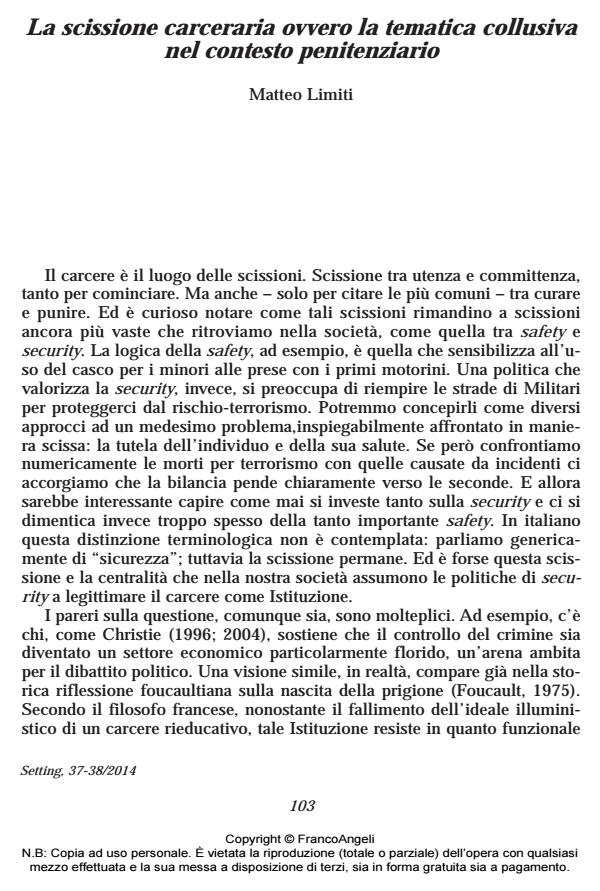La scissione carceraria ovvero la tematica collusiva nel contesto penitenziario
Journal title SETTING
Author/s Matteo Limiti
Publishing Year 2015 Issue 2014/37-38 Language Italian
Pages 13 P. 103-115 File size 431 KB
DOI 10.3280/SET2014-037006
DOI is like a bar code for intellectual property: to have more infomation
click here
Below, you can see the article first page
If you want to buy this article in PDF format, you can do it, following the instructions to buy download credits

FrancoAngeli is member of Publishers International Linking Association, Inc (PILA), a not-for-profit association which run the CrossRef service enabling links to and from online scholarly content.
The article, starting from an overview of the prison as a place of splittings, examines the collusion risk factor that each operator working in prison is necessarily facing. A split Institution - as the prison is - easily leads to side and thus to collude. Starting from the etymological root of the word "collusion" and its use in the law, it gives then a definition of the term as used in Psychology to place it in the prison context. The article analyzes three different "collusive temptations" according to the different partners involved in the relationship: the client, the prison Officers and the prisoners. This leads finally to a new definition of the term "collusion", wider and not merely negative, borrowed from Renzo Carli
- Klein M. (1932), Die Psychoanalyse des Kindes, Internaler Psa. Verlag, Wien (tr. it. La psicoanalisi dei bambini, Martinelli, Firenze, 1969).
- Laing R.D. (1959), The Self and Others, Tavistock Publications Limited, London (tr. it. L’io e gli altri: psicopatologia dei processi interattivi, Sansoni, Firenze, 1969).
- Lingiardi V., Madeddu F. (2002), I meccanismi di difesa. Teoria, valutazione, clinica, Raffaello Cortina, Milano.
- Lourau R. (1970), L’analyse institutionnelle, Les Éditions de Minuit, Paris.
- Brossat A. (2001), Pour en finir avec la prison, La Fabrique, Paris (tr. it. Scarcerare la società, Elèuthera, Milano, 2003.
- Camus A. (1942), L’Étranger, Gallimard, Paris (tr. it. Lo Straniero, Bompiani, Milano, 1947).
- Carli R. (1990), “Il processo di collusione nelle rappresentazioni sociali”, Rivista di psicologia clinica, 4: 282-296.
- Carli R. (1982), “Per una teoria dell’analisi istituzionale”, in R. Carli e L. Ambrosiano (a cura di), Esperienze di psicosociologia, FrancoAngeli, Milano.
- Carli R., Paniccia R.M. (1981), Psicosociologia delle organizzazioni e delle istituzioni, il Mulino, Bologna.
- Christie N. (2004), A suitable amount of crime, Routledge, London (tr. it. Una modica quantità di crimine. Società monoistituzionale e cultura della pena, Edizioni Colibrì, Milano, 2012).
- Christie N. (1993), Crime control as industry: towards gulags, Western style? Routledge, London (tr. it. Il Business Penitenziario. La via occidentale al Gulag, Elèuthera, Milano, 1996).
- Clemmer D. (1940), The prison community, Christopher Publishing House, Boston (tr. it. La comunità carceraria, Giappichelli, Torino, 1997).
- Dicks H.V. (1967), Marital Tensions, Routledge & Kegan Paul Ltd., London (tr. it. Tensioni coniugali, Edizioni Borla, Roma, 1992).
- Durkheim É. (1899-1900), “Deux lois de l’évolution penale”, L’année sociologique, 4: 65-95.
- Foucault M. (1975), Surveiller et punir. Naissance de la prison, Gallimard, Paris (tr. it. Sorvegliare e punire. Nascita della prigione, Einaudi, Torino, 1976).
- Goffman E. (1961), Asylums: essays on the social situation of mental patients and other inmates, Anchor Books, Doubleday & Company, Inc., New York (tr. it. Asylums. Le istituzioni totali: i meccanismi dell’esclusione e della violenza, Einaudi, Torino, 1968).
- Margara A. (1993), “La pena perduta e il carcere ritrovato: riflessione sulla crisi di una delle tante riforme incompiute”, Questione Giustizia, 12: 381-403.
- Martin H. (1989), “Types of institutional transference”, Bull. Meninger Clinic, 53: 58-62.
- Montecchi L. (2012), Implicazione, Sensibili alle foglie, Tivoli.
- Nietzsche F.W. (1886), Jenseits von Gut und Böse. Vorspiel einer Philosophie der Zukunft, Druck und Verlag von C.G. Naumann, Leipzig (tr. it. Al di là del bene e del male: preludio di una filosofia dell’avvenire, Adelphi, Milano, 1968).
- Rider N. (1953), “A type of transference to institutions”, Bull. Meninger Clinic, 17: 58-43.
- Salluzzo M.A. (2008), “La collusione del consulente col sistema giudiziario”, www.Psicologiagiuridica.net.
- Santoro E. (1997), Carcere e società liberale, Giappichelli, Torino.
- Sarzotti C. (1999), “Codice paterno e codice materno nella cultura giuridica degli operatori penitenziari”, in A.R. Favretto e C. Sarzotti (a cura di), Le carceri dell’AIDS.
- Indagine su tre realtà italiane, L’Harmattan Italia, Torino, 9-84.
- Semple J. (1993), Bentham’s prison: a study of the Panopticon penitentiary, Clarendon Press, Oxford.
- Willi J. (1982), Couples in Collusion, Jason Aronson, New York (tr. it. La collusione di coppia, FrancoAngeli, Milano, 1986).
Matteo Limiti, La scissione carceraria ovvero la tematica collusiva nel contesto penitenziario in "SETTING" 37-38/2014, pp 103-115, DOI: 10.3280/SET2014-037006